
I first came to the Alexander Technique with the hope of preventing potential future problems, having a family history of serious back and neck conditions. Not only was I able to change my habitual movement patterns to reduce unecessary strains on my back and joints, but I also discovered many other benefits that I carried into my daily life. Every lesson brought a sense of well-being and my calmer state of mind helped me cope better with a stressful job. For the first time, because of my improved posture, I was also able to sit comfortably at my computer. As someone who was originally involved in scientific research and who then spent many years in a desk job in the pharmaceutical industry, I continually ‘lived in my head’. Through the Alexander Technique I have gradually integrated thinking and activity, for a better coordinated mind-body.
After several years of lessons, which began in 1998, I decided to train as a teacher and in 2006 completed the 3-year full-time training course at the Manchester Alexander Technique Training School. I am accredited by STAT and also registered with the CNHC. I have been active in teaching since qualifying and am now based in Portobello, Edinburgh where I offer individual lessons, as well as running group courses and workshops. I also work with businesses and organisations on workplace well-being and performance.
I actively pursue continuing professional development and have a particular interest in the Alexander Technique as an adjunct for people living with chronic pain, trauma, or hypermobility.
I am the Head of Training at Edinburgh Alexander Training School, currently the only accredited Alexander Technique teacher training course in Scotland.
I am the Chair of STAT’s Research Group, being active in communicating about Alexander Technique research within the profession and with the wider public. I was a core member of the study team for the clinical trial of Alexander lessons for people with chronic neck pain and was a Visiting Research Fellow at the University of York (2011 to 2018). I have published several articles on the findings of the neck pain trial; other academic publications include a review of the effectiveness of Alexander lessons for different health problems. I also enjoy writing about the Alexander Technique for the general public, with magazine articles and a monthly blog post.